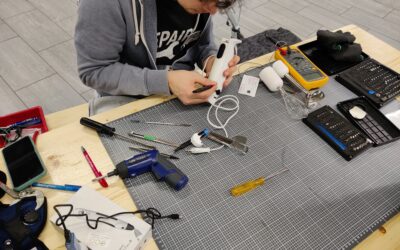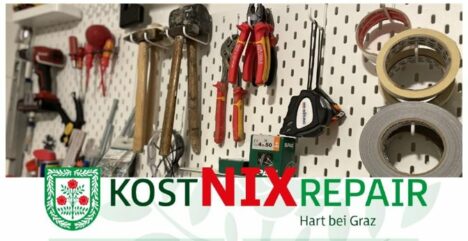Original post by bea on December 30, 2022. Translated by Lisa Scheer in 2023/24.
Disclaimer: Some of the links in this post might redirect you to a site in German. Feel free to use Machine Translation (such as DeepL or Google Translate) to get the information provided on these sites.
A strategy of our throw-away society
Does the battery of your phone only last for half a day after a couple of months? Do you feel like printers are almost cheaper than their ink? Are your headphones affected by predetermined breaking points quickly? This is not only due to our behaviours and bad treatment of our things. In a lot of cases the reason is a thought-through marketing strategy. It aims to get products to break „on time“. The products should only last for as long as necessary, but in no case as long as possible. This phenomenon is called planned obsolescence.
But why is it done? To push the economy, demand and the sale of new products. Nothing is worse for the economy than people using their appliances, their clothes and other things for forever. We buy, we throw away and buy again. At the same time, we are approaching dangerous points when it comes to climate system. Planned obsolescence alongside advertisements and credits is one of the three pillars of our growth-driven society.
What is obsolescence?
The word obsolescence (lat. obsolescere, „to fall into oblivion“) is the economic word for the aging of products, their wear and tear. This is nothing uncommon and just happens. Just as when a computer isn’t up to date anymore or when an appliance breaks through „natural“ wear and it has to be replaced.
If, however, this wear and tear is deliberately relied upon, we speak of „planned obsolescence“ – this is deliberately cheating the customers. Unfortunately, you can no longer prove this, because it’s impossible to differentiate between it and normal wear and tear. Electrical devices become cheaper and cheaper and are replaced more quickly. This leads a lot of manufacturers using even cheaper pieces. A lack of interest can be quickly assumed, but it is difficult to prove malicious intent.
Different kinds of obsolescence
- Material obsolescence: The product or even (small) parts of the product are less efficient. For examples the small battery of phones or the graphic cards within laptops. Theoretically, almost every product can be repaired, so you don’t have to replace it. Because of planned obsolescence, products are often built in a way that makes replacing parts difficult. This leads to them being replaced entirely instead. A lot of products are glued together instead of screwed together these days. This makes repairs more difficult or impossible.
- Functional obsolescence: Happens through updates and renewals that do no longer work on old products. Like this, we feel forced to replace them.
- Psychological obsolescence: Fashion trends and improved technologies create the wish to buy a new piece of clothing or a new device. Our old device might still work fine and our wardrobe might be bursting already. Colours and designs are often exchanged so that old and new products can be differentiated between easily. We are not forced into planned obsolescence, we are tempted.
- Economical Obsolescence: The repair of broken devices is often more expensive than just buying a new one.
Historical aspects of and interesting things about obsolescence
Planned obsolescence has been around for a while. The expression was first mentioned in a scientific article in 1932. The car industry was very powerful already back then: In the 1920s, consumption strategies have been created so that people would buy a new car every three years. General Motors developed a new design strategy to beat their opponent Ford. It was a success. The sturdy, but less attractive T-model by Ford was removed from the market in 1927. From then on, Ford developed a new model each year.

The most well-known case of planned obsolescence was the one of the Phoebus cartel in Geneva. Lightbulb manufacturers from all over the world (such as Osram or Philips) decided to reduce the life of lightbulbs from 2500 hours (which was a long time) slowly and unnoticeably to 1000 hours. This should increase demand. Because the market was already oversaturated back then. In 1940, the goal of 1000 hours was reached and the was sold to consumers as a positive aspect. 1942 the cartel was exposed. The process took eleven years and ended with the prohibition of the restriction of the life of products. Practically this did not cause any changes though. Lightbulbs were still not burning for as many hours as they did before.
Interesting fact: Ever since 1901, the same lightbulb has been hanging and burning in a fire station in Livermore (USA, California). In 1895, this „centennial bulb“ was produced with a long-lasting filament.
In 1940, long-lasting nylon stockings were created. Sales stagnated and the life of stockings had to be shortened by changing the components. So soon there were runners again, gradually they became more and more sensitive.
Examples for planned obsolescence:
There are countless products that rely on premature wear. Here are some examples from our everyday life:
Notebooks: Average notebooks by current market leaders are often impossible to repair yourself. Even in warranty cases, they rarely repair them, but rather replace them. One-way screws and gluing are common ways to make repairs difficult.
Phones: Which reasons do exist for the premature purchase of a new phone? The battery is built in the phone and/or programmed to last for a certain number of charging cycles. The mobile phone contract offers a cheap new device every 2 years, updates of the operating system slow down the device, the new device looks better, connections for charging cables no longer fit, and more.
Overheating of electrical devices: TVs, screens and more are often built in a way so that they become unusable after a few years due to constant overheating. Old tube devices, on the other hand, usually still work after several decades.
Clothing and shoes: Cheap plastic soles, bad quality of cotton and more. This causes denim to wear „out“ really quickly. You often cannot wear shoes after half a year. The worst part: repairs are often impossible.
Toothpaste: The holes of toothpaste tubes are often made bigger to get more toothpaste on the toothbrush of consumers on an everyday basis.
Can you think of anything else?
Strategies against planned obsolescence
The best strategy for longer lifetimes for objects would be policies. For example, longer warranties, the provision of spare parts or the commitment to a minimum range of updates. This will take time. But what can we do?
Less consumption
Do we truly need the newest devices, the most recent clothing pieces and the fastest cars? A piece of advice: Just buy what you truly need, because the most environmentally friendly product is the one that we already have.
Borrowing instead of buying and sharing
This is true for many things that we do not need on a daily basis. Just like carsharing, tools but also parts for washing machines or lawn mowers. There is a lot that we can share. Using instead of owning.
Repairing instead of throwing away
An important step is to make sure to buy repairable products and to try and repair them when they break. Ask manufacturers if they pay attention to repairability so that they know that consumers wish for it. Ask for spare parts and try to repair your things yourself. There are DIY instructions for repairs online (try Google) and Repair-Cafés can help you as well. There is also financial aid for repairs. In Austria a Repair bonus already exists.
The right to repairs
A trend working against planned obsolescence is the right to repair movement. This calls for legislature when it comes to the following:
- Access to affordable spare parts
- Access to spare parts from old equipment
- Provision of repair manuals
- Provision of technical data and diagnostic tools
- Repair-friendly devices
Buy quality and long-lived products
When buying things, pay attention to quality. More expensive doesn’t always mean better. Especially when it comes to notebooks there is a drastic difference in quality when it comes to price. Quality electronic devices are more expensive than cheaply produced mass products. The keyword cheap is generally central, because the mass production of all kinds of goods often makes it impossible or not profitable for the manufacturer to produce high quality. Buying wholesale may be cheap and convenient, but in the end it is not you who benefits, but manufacturers of cheap products and advocates of the throwaway society. It is also important to prefer products made from renewable materials. Pay attention to test marks, customer reviews and guides.
Passing on things you no longer need
Not everything old is automatically bad. If you no longer like your old shoes, give them to someone who might need them. Go to flea markets, participate in exchanges, visit a Kostnixladen and become active.
Buy second-hand
Buy old devices to counteract the consumption cycle. We have already posted about some companies from Graz such as Compuritas and Refurbed.
Shop at (small) businesses that are trusted by the community
…not in anonymous online businesses. Because these small businesses need a good reputation. They try to create trust and to keep it. Therefore, favour actors who put collective interest, resource conservation, climate protection and satisfied customers before profit.
Ignore useless trends
Create your own trends, your own style and be proud of it!
Get involved
Sign petitions, raise your voice, spread the news to other people. Ask questions, expect longevity and stand up against consumerism.
If we prolonged the life of all smartphones in Europe by one year, we could conserve 2.1 million tons of CO2 annually. This amounts to a million cars that are removed from the streets.
Dorothea Kessler (iFixit Europe)
Sources:
- https://de.wikipedia.org/wiki/Geplante_Obsoleszenz
- https://www.focus.de/finanzen/praxistipps/geplante-obsoleszenz-das-steckt-dahinter_id_8318311.html
- www.oeko.de/oekodoc/2326/2014-759-de.pdf
- https://praxistipps.chip.de/geplante-obsoleszenz-das-steckt-dahinter_96676
- https://www.careelite.de/geplante-obsoleszenz/
- https://neofix.ch/blog/recht-auf-reparatur-5-gruende/
- https://neofix.ch/blog/elektronik-kaputt-ursachen/
Anmerkung der NiG-Redaktion:
Falls du keine wichtigen Beiträge oder Termine von uns verpassen willst, abonnier doch bitte gerne unseren Newsletter! Er kommt unregelmäßig und nicht zu häufig – versprochen. Oder schau regelmäßig in unseren Veranstaltungskalender.
Wenn dir gefällt, was wir auf dieser Plattform tun, nämlich bereits seit 2017 über Nachhaltigkeit, Umwelt- und Klimaschutz zu informieren, dann unterstütz uns doch bitte auch finanziell, um unsere Website in dieser Qualität und Fülle weiterführen zu können – uns hilft jeder Beitrag!
Verein „Nachhaltig in Graz“
BIC: STSPAT2GXXX
IBAN: AT20 2081 5000 4200 1552
Verwendungszweck: Spende/Sponsoring (Mehr zum Sponsoring hier)
Du kannst dir auch gerne unsere kostenlose App aufs Handy laden, damit kannst du Informationen, Veranstaltungen und vieles mehr entdecken: App Nachhaltig in Graz












